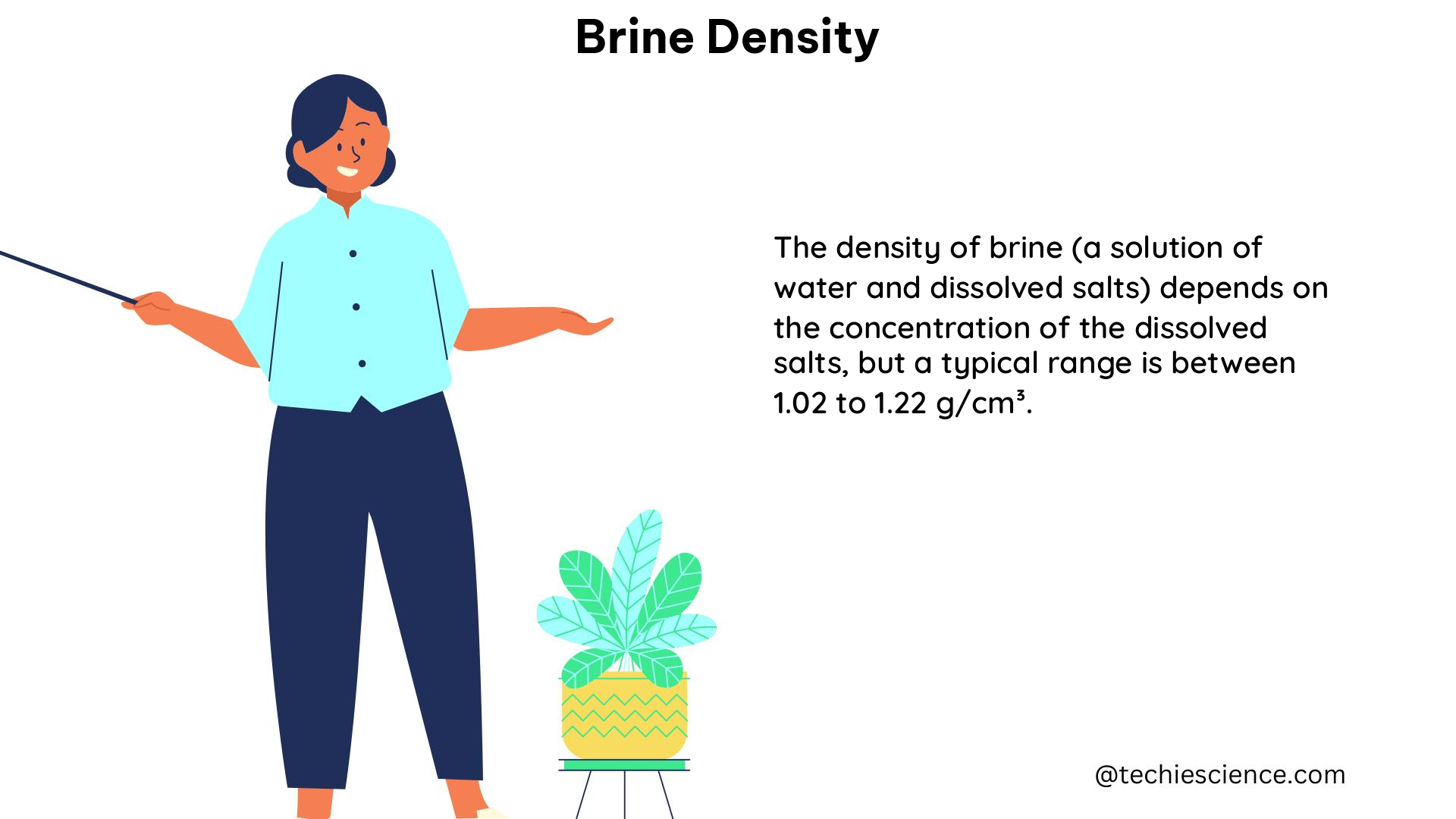Brine density is a critical parameter in various industrial and scientific applications, including geothermal energy production, oil and gas recovery, and chemical engineering processes. Understanding the factors that influence brine density and the methods used to measure and estimate it is essential for efficient system design and optimization.
Factors Affecting Brine Density
The density of brine is primarily influenced by three key factors:
-
Temperature: As the temperature of brine increases, its density generally decreases. This is due to the thermal expansion of the brine, which causes the molecules to move further apart, reducing the overall density.
-
Pressure: Increasing the pressure on brine can lead to a slight increase in its density. This is because the higher pressure compresses the brine, causing the molecules to move closer together, resulting in a higher density.
-
Salt Concentration: The concentration of dissolved salts, such as sodium chloride (NaCl), in the brine has a significant impact on its density. As the salt concentration increases, the density of the brine also increases.
Measuring Brine Density

There are several methods available for measuring the density of brine, each with its own advantages and limitations. The choice of method depends on factors such as the required accuracy, the available equipment, and the specific application.
Hydrometer Method
The hydrometer method is a simple and inexpensive way to measure the density of brine. It involves immersing a hydrometer, a calibrated glass or plastic float, into the brine sample. The depth to which the hydrometer sinks is directly related to the density of the brine, which can be read directly from the hydrometer’s scale.
Oscillating U-Tube Method
The oscillating U-tube method is a more accurate technique for measuring brine density. It involves filling a U-shaped glass or metal tube with the brine sample and measuring the frequency of oscillation of the tube. The density of the brine can then be calculated from the measured frequency using a calibration equation.
Vibrating-Tube Densimeter Method
The vibrating-tube densimeter method is another accurate technique for measuring brine density. It works on the principle of measuring the frequency of vibration of a U-shaped or straight tube filled with the brine sample. The density of the brine can be calculated from the measured frequency using a calibration equation.
Estimating Brine Density
In addition to direct measurement, the density of brine can also be estimated using theoretical models. One of the most widely used models is the Pitzer ionic interaction model, which is a thermodynamic model that describes the behavior of electrolyte solutions, including brine.
The Pitzer model can be used to estimate the density and compressibility of natural hypersaline brines, such as those found in the Red Sea, Dead Sea, Orca Basin, and Mono Lake. The model takes into account the concentration of various dissolved salts, as well as the temperature and pressure of the brine.
Brine Density Data and Applications
The density of brine can be expressed in units of kilograms per cubic meter (kg/m³) or grams per cubic centimeter (g/cm³). Some typical values for brine density include:
- Seawater: Approximately 1,025 kg/m³ or 1.025 g/cm³
- Brine with high salt concentration: Up to 1,200 kg/m³ or 1.2 g/cm³
Accurate knowledge of brine density is crucial in various applications, such as:
-
Geothermal Energy Production: Brine density is a key parameter in the design and operation of geothermal power plants, as it affects the flow and heat transfer characteristics of the brine.
-
Oil and Gas Recovery: Brine density is important in the design and operation of oil and gas wells, as it affects the buoyancy and flow of the fluids in the reservoir.
-
Chemical Engineering Processes: Brine density is a critical parameter in various chemical engineering processes, such as desalination, water treatment, and the production of chemicals from brine.
-
Oceanography and Marine Science: Brine density is an important parameter in the study of ocean currents, water masses, and other oceanographic phenomena.
Conclusion
Brine density is a critical parameter that must be accurately determined for efficient system design and optimization in various industrial and scientific applications. By understanding the factors that influence brine density, the methods used to measure and estimate it, and the available data and applications, engineers and scientists can make informed decisions and develop effective solutions.
References
- Francke, H., & Thorade, M. (2010). Density and viscosity of brine: An overview from a process engineers perspective. Chemie Ingenieur Technik, 82(8), 1261-1268.
- Ahmed, M., Shayya, W. H., Hoey, D., & Al-Handaly, J. (2000). Brine disposal from reverse osmosis desalination plants in Oman and the United Arab Emirates. Desalination, 133(2-3), 135-147.
- Measuring Brine Density – YouTube. (n.d.). Retrieved from https://www.youtube.com/watch?v=pCWCfrbxbis
- On the Estimation of the Density of Brine with an Extensive Range of Different Salts Compositions and Concentrations. (n.d.). Retrieved from https://www.researchgate.net/publication/306085474_On_the_Estimation_of_the_Density_of_Brine_with_an_Extensive_Range_of_Different_Salts_Compositions_and_Concentrations

The lambdageeks.com Core SME Team is a group of experienced subject matter experts from diverse scientific and technical fields including Physics, Chemistry, Technology,Electronics & Electrical Engineering, Automotive, Mechanical Engineering. Our team collaborates to create high-quality, well-researched articles on a wide range of science and technology topics for the lambdageeks.com website.
All Our Senior SME are having more than 7 Years of experience in the respective fields . They are either Working Industry Professionals or assocaited With different Universities. Refer Our Authors Page to get to know About our Core SMEs.